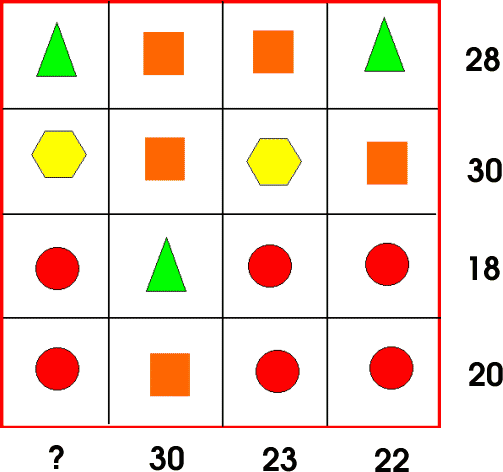NRICH resources for every occasion
This article is part of Enriching the Secondary Curriculum.
Rich tasks can serve a variety of purposes. We thought it might be useful to categorise some of our favourite problems according to why they might be used.

Imagine it's the start of a new term. You have new and enthusiastic classes and you are desperate to get them engaged with rich tasks straight away. The Factors and Multiples Puzzle is a great task for small groups of students to work on. It requires recall of the properties of numbers, and plenty of mathematical reasoning. By listening in on students' discussions as they work, you can get a feel for what they know and what they might need to revise, as well as getting a sense of how well they can speak confidently about mathematical ideas and reason effectively.

Another favourite task for the start of term is Summing Consecutive Numbers. The only prior knowledge needed is the ability to add numbers. It's a great way of getting a feel for how well students notice and explain patterns, and as it extends into sophisticated mathematical thinking (why is it impossible to write powers of 2 as the sum of consecutive numbers?), it really is a task you could use with virtually any group!

When introducing new ideas to a class, rich tasks can offer the opportunity for students to build on existing knowledge. Perimeter Expressions requires understanding of perimeter, and introduces students to the idea of collecting like terms in an intuitive way. Vector Journeys also taps into students' intuition, inviting them to draw squares and their diagonals and notice patterns in their vector representations. What's it Worth? is an exercise in simultaneous equations, but the symbolic presentation is inviting, and allows students to approach solving equations as detective work, looking for elegant methods of eliminating variables. Once students have had an opportunity to engage with new concepts in an intuitive and playful way they are better able to make sense of formal mathematical approaches.
It's not just new ideas that can be taught using rich tasks. Students require opportunities to practise basic mathematical skills, but it needn't be boring. By replacing traditional fluency or consolidation exercises with rich tasks, this practice can be purposeful and engaging. Here are some of our favourite NRICH tasks for consolidation or fluency:
Isosceles Triangles - coordinates, area of triangles
As well as offering pen and paper tasks, we also publish interactive content for use in computer rooms or on laptops or tablets. We design interactivities which require students to reason, and if they are working in pairs, these interactivities can be used for discussion and collaboration. Mixing Lemonade is a ratio activity, and while an individual problem can be guessed at, challenging students to get ten correct answers in a row requires them to develop a method. Shifting Times Tables is a sequence activity with several different levels so that students can work on each level until they are confident, and then move on. To solve the hardest problems, students need to develop a strategy. Charlie's Delightful Machine makes a good follow-up problem.

Working on rich tasks offers students the opportunity to develop important mathematical insights for themselves. We are particularly keen on students learning to identify underlying structure in a mathematical situation and using their insights to explain any patterns they notice. Seven Squares, Painted Cube, Steel Cables and Attractive Tablecloths all lead to generalisations that can be explained with reference to the geometrical structure of a situation. The article Train Spotters' Paradise by Dave Hewitt is well worth a read if you are interested in the importance of a structural approach.
One phrase that we use to describe many of our tasks is low threshold high ceiling. We use this to mean tasks that have accessible starting points together with more challenging follow-up questions. Every student can get started, and the tasks have the potential to take some students on a rich mathematical journey leading to new insights, exciting generalisations and proofs. Here are some of our favourites:

Finally, this article would not be complete without mentioning two of our favourite mathematical games we'd love every student to play. In Got It, the parameters of the game can be tweaked so that students must solve the general strategy for all possible targets and starting numbers. The first challenge in the Factors and Multiples Game is to find a winning strategy. The game can then be adapted to become a challenge that can keep students (and their teachers) busy for weeks... months... even years!
We hope this article has given you some new ideas on how to use NRICH tasks, as well as introducing you to some problems you may not have known about. Problems have additional information about classroom use in the Teachers' Resources link, together with hints and solutions. Of course, there are many more tasks that we didn't have room to mention here, so take a look at our Secondary Curriculum page for resources linked to all the curriculum areas.
